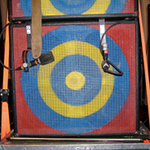David Palmer
New Paintings
Virgil de Voldère Gallery
526 West 26th Street, Room 416, New York, NY
April 16–May 16, 2009
Virgil de Voldère Gallery is proud to present its third solo exhibition of large-scale paintings by David Palmer. Rigorously exploring the single brushstroke, Palmer’s new works push the inner complexity of a form and process—piercing blue paint swept across a cool white canvas with a large brush—that he has pursued since 2000.
Painters such as David Reed and James Nares have also tackled the legacy of the brushstroke in modern art, from Impressionism to Abstract Expressionism to today, but what sets Palmer apart is that his singular movements are rendered perfectly, sharp as a satin ribbon, without extraneous drips, splashes, or splotches. This technique often fools viewers into thinking the images are photographic or digital in nature, but they’re entirely handmade.
Further, in what could be called a hypergesture, a solitary Palmer swoosh is tightly composed to the point of becoming emblematic. Like logos or symbols, these paintings exhibit a flawlessness of construction and an innate sense of rightness, as if anything added, taken away, or moved would throw everything out of balance. All the while the artist preserves a unique, mysterious energy: with no distinguishable starting or end point, a brushstroke becomes a revolving, infinite loop of color and a vortex of pure visuality.
The viewer may try to make sense of Palmer’s images, which could suggest an infinite array of things such as twisting balloon animals, fanciful clouds, or distorted inkblot halves, but such interpretations aren’t intended. Palmer says, “When my ideas begin to become suggestive of real-world objects I discard them. Unlike Jasper Johns, I tend to like things that ‘did not’ previously exist.” However, because of the paintings’ human scale (they are sixty-two inches square) and also their titles (each work is given a female name), the paintings become uniquely individualized—not quite people or portraits but something analogously parallel and emotionally familiar.
